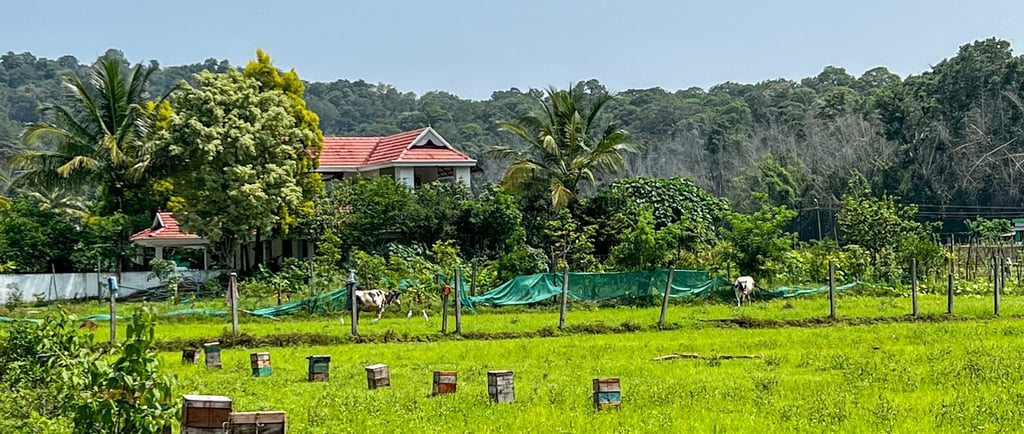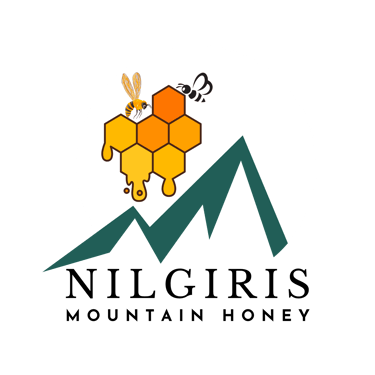Support Traditional Honey Harvesting in the Nilgiris
Nilgiri honey, harvested by indigenous communities Irulas, Kurumbas,Todas -Support traditional practices and biodiversity conservation with each purchase.


Nigiris Honey process
Selecting Site:
In a honey collection process, how do I select the best site based on blooming flowers?
Honeybees collect nectar as soon as flowers start to bloom from a variety of flowers, which makes multi-flower honey. It is important to select the right place for honey collection in relation to the flowering season of the flower so that the honey produced will be of the best quality. To ensure that the bees have a constant and varied nectar source throughout the season, the ideal location must be chosen with consideration for when the local flowering plants will bloom. This careful preparation can lead to more variation and a deeper flavor.
Setting up the colonies:
How do I get honeybees to make their colonies in a manner that maximizes nectar collection?
The first step in establishing a honeybee colony is to provide wooden "houses," or hives, for bees to store their nectar and honey.
If bees are to remain healthy and productive, the hive must be located in a location that will best serve this purpose. The site should provide access to sufficient nectar sources, protection from extreme weather, and enough space for the colony to expand. Keeping a healthy colony also relies on proper hive preparation, which includes ensuring the hive is clean, well-ventilated, and stocked with the right supplies. The bees can thrive and efficiently produce honey if the right conditions are met.
Timing everything perfectly:
How do I time the honey harvest and monitor bee activity effectively?
For a honey harvest to be successful, timing is important. To find the ideal times for recurring checks, we use charts developed from experience. We can assess bee productivity and make sure the colony is healthy by monitoring bee activity. Keeping an eye on the weather prediction is also crucial because bad weather tends to make bees less busy. The honey is ready to be harvested after the honeycomb is completely shut. A high-quality and effective honey gathering process is ensured by these attentive monitoring and prompt measures.
How to Make It Naturally:
In comparison to processed honey, how can eating raw, unprocessed honey—which is high in natural enzymes and antioxidants—benefit your health?
Our organization is dedicated to maintaining the honey's natural integrity. To preserve its natural enzymes and nutritional worth, we make sure that our raw honey is not heated or processed. Due to cautious processing, our honey has been able to preserve its natural antioxidants, which help shield your body from free radical-induced cell damage.
Selecting our raw honey means you're supporting a product that remains loyal to its natural source and provides purity as well as possible health advantages.
Fulfilling the Nilgiris Honey:
In what ways does gravity filtering improve raw honey's purity without sacrificing its inherent characteristics?
Before bottling and packing, Nilgiris Honey uses a simple gravity filtration technique to get rid of undesirable particles like air bubbles and wax fragments. This easy method improves the honey's clarity without changing its inherent qualities.
Local Nilgiris Tribes Honey process:
Tradition also relates to the local honey harvesting within the Nilgiris region, which is integral to the ancient culture of an indigenous people and tribes such as the Irulas and Kurumbas and Todas. The tribals have harvested honey from a wild bee through sustainable methods. This has significantly minimized the irritation of the bee and its dwellings.
Traditional Honey Harvesting Techniques:
Irulas and Kurumbas: collect honey from tree trunks and cliff-side combs of the Giant honey bee, Apis dorsata. They adopt very environmentally friendly harvesting techniques; many use smoke prepared from specific herbs to make bees leave the hive without damaging any of them. The combs are cut so carefully that no destruction of the brood occurs. This way, continuity of the colony is ensured.
Todas: They live at high altitudes and extract honey from Apis cerana indica (Asian honey bee) hives located in hollow tree cavities. Each family has traditional rights to specific trees, and while extracting honey, they blow gently into the cavity to soothe the bees and remove only the combs containing honey, leaving the brood. In this way, the bees will return to the same spot the following year.
Paniya: One important collection of honey here is in the forests near Mudumalai, more specifically around Gudalur. The flowers bloom profusely after the months of January and February; thus, the best month to collect honey is during on April. Pre-collection, they should first track the location of hives and continue surveillance so that there will be minimal interference from the local animals. Such deep forests contain many bears since they are inquisitive for sweet things like honey. Hence, it is important to be watchful during the day and night during the honey harvesting period.
Processing and Preservation:
After harvesting, honey is processed very minimally so that it retains all its natural properties. The honey is filtered through basic gravity filtration to remove unwanted particles like wax and debris before bottling. This simple method preserves the honey's natural enzymes, antioxidants, and nutritional value, offering consumers pure and unadulterated honey.
Sustainable Practices:
Indian Nilgiri honey hunters maintain ecological balance and respect the honey as well by simply taking just about what they required, while retaining a huge bulk of the population undisturbed. This further gives them scope towards regenerating honey bee colonies whereas maintains ecological conditions of forests that is to support their population naturally. They share great concern through respect and local knowledge to manage bee population which conserves within the region of Nilgiri.
Consumers will be supporting these ancient sustainable practices by choosing Nilgiris honey and enjoying a product that represents the rich biodiversity and cultural heritage of the Nilgiris region.
Contact
© 2025. All rights Nilgirishoney


Gift Packs
FAQ's
